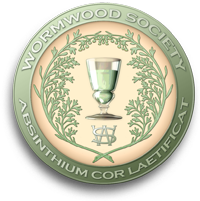
Absinthe: The Rise, Fall and Resurrection of the Green Fairy
Absinthe Known
What is absinthe?
Although wormwood-infused drinks have been used in medicine for thousands of years, when we speak of “absinthe” nowadays, we are evoking a very specific spirituous liquor that rose to popularity in France and Switzerland beginning in the late 18th century.
To put it concisely: Absinthe is an anise-flavored aperitif distilled from anise, fennel and wormwood. Authentic absinthe is usually either green or clear, that is verte or blanche. When colored green, other herbs are used after distillation—as much for their flavoring and aromatic properties as for color. It is their chlorophyll that gives the peridot green hue for which absinthe is famous and which earned it the sobriquet, La Fée Verte, The Green Fairy. There is one known instance that has very recently come to light of a pre-ban rouge, or red absinthe. Little more is known of it so far than the simple fact that it existed, as shown by an advertising poster from the era.
Although absinthe is often referred to as a liqueur, this is not wholly accurate, as liqueurs are pre-sweetened and often somewhat syrupy. Absinthe is not pre-sweetened and is somewhat astringent and mildly bitter, but nowhere near as bitter as popular imagination would have it; not even so much as unsweetened tea.
Absinthe takes its name from its principle ingredient, grand wormwood, whose botanical name is Artemisia absinthium. “Absinthe” is the French word for the wormwood plant; the full proper name of the liquor, Extrait d’Absinthe, simply translates as Wormwood Extract. Other traditional ingredients include anise (Pimpinella anisum) , Florence fennel (Foeniculum vulgare, var. azoricum), petite wormwood (Artemisia pontica), melissa (Melissa officinalis) and hyssop (Hyssopus officinalis).
Absinthe is made by macerating the herbs for a brief time in 85 percent spirits, which mixture is then distilled, carrying the fragrant, volatile herbal oils into the liquor, leaving the vegetal matter and undesirable bitter compounds behind in the still. Absinthe is generally found in the proof range of 55 to 74 percent alcohol and is expressed in degrees of proof equivalent to alcohol percentage, i.e. 55° equals 55 percent alcohol by volume.
In spite of internet and popular culture claims to the contrary, absinthe cannot be made at home from a kit by soaking herbs in spirits. This can be compared to soaking barley in spirits to make whisky or adding grape Kool-Aid™ to diluted neutral spirits to make wine.
